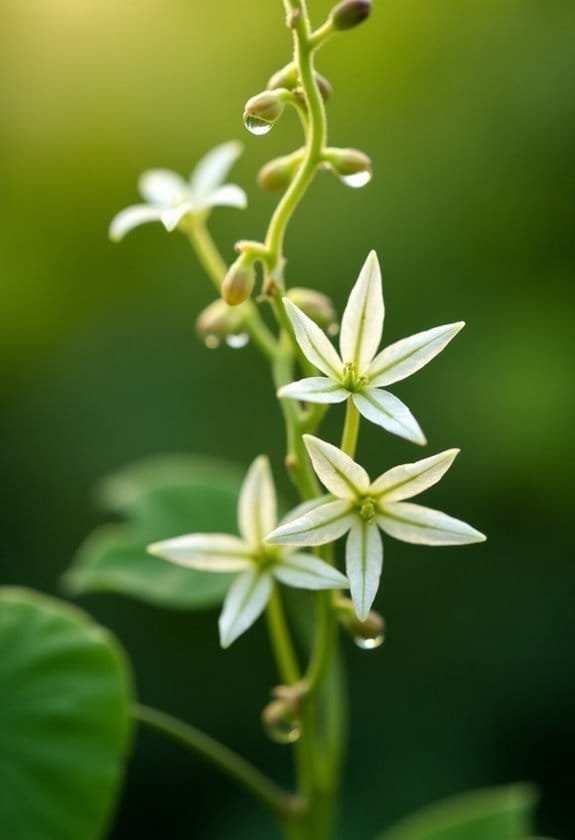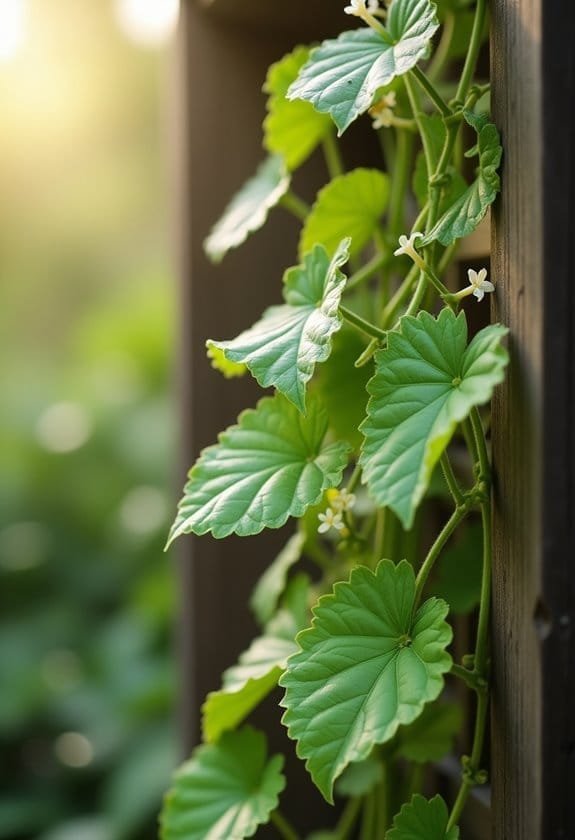White bryony is a vigorous climbing perennial that's both fascinating and dangerous, reaching heights of up to 4 meters through its spiral tendrils. It's distinguished by five-lobed leaves and greenish-white flowers that bloom from May to August, followed by striking red berries in autumn. Though it belongs to the Cucurbitaceae family, this dioecious plant shouldn't be mistaken for a friendly garden companion – all parts contain potent toxins that can cause severe gastrointestinal distress. While it's commonly found in hedgerows across southern and eastern England, its extensive root system and historical significance hold intriguing secrets beneath its deceptively attractive exterior.
Main Points
- White bryony is a toxic climbing perennial plant reaching heights of 4 meters with five-lobed leaves and greenish-white flowers.
- The plant produces bright red berries in autumn and belongs to the Cucurbitaceae family, with separate male and female plants.
- It thrives in well-drained soil and full sunlight, requiring temperatures between 15-25°C and regular watering during growing season.
- All parts of the plant are highly toxic, causing severe gastrointestinal distress if ingested and potential skin inflammation upon contact.
- White bryony grows extensively in Central and Southern Europe, commonly found in hedgerows and woodland margins.
Introduction

White bryony (Bryonia dioica) stands as a remarkable climbing perennial that graces the hedgerows and woodlands of southern and eastern England.
Its distinct five-lobed leaves and spiraling tendrils allow this vigorous climber to reach impressive heights of up to 4 meters, creating natural curtains of greenery along its chosen supports.
The plant showcases its seasonal transformation through greenish-white flowers that bloom from May to August, followed by striking red berries that persist through winter, though these attractive features belie its highly toxic nature.
Common Name
Known throughout Europe as white bryony, Bryonia dioica has earned several common names that reflect its characteristics and historical uses. The plant's most widespread alternative name, common bryony, acknowledges its prevalence across European landscapes, where it flourishes as a climbing perennial in various habitats.
Perhaps most intriguingly, the species carries the name English mandrake, though this designation potentially misleads as it bears no botanical relation to true mandrake plants. The term red-berried bryony accurately describes one of its most distinctive features: the bright crimson berries that appear during winter months, serving as a warning sign of the plant's significant toxicity.
These various names have evolved through centuries of human interaction with the plant, each highlighting different aspects of its nature. While white bryony refers to the plant's delicate greenish-white flowers that bloom from May to August, the scientific name Bryonia dioica provides the most precise identification for this member of the Cucurbitaceae family.
This taxonomic classification connects it to its cultivated cousins, the cucumbers, though white bryony's toxic properties set it distinctly apart from its edible relatives.
Scientific Name
Classification precision defines Bryonia dioica as the accepted scientific name for white bryony, placing it firmly within the Cucurbitaceae family alongside cultivated cucumbers and gourds.
The plant's complete taxonomic designation includes its subspecies classification, Bryonia cretica L. ssp. dioica, which helps botanists distinguish it from related varieties within the genus.
The scientific name carries significant meaning, particularly in its specific epithet "dioica," which provides insight into the plant's reproductive nature. This term directly references the species' dioecious characteristic, where male and female reproductive structures develop on separate plants, a relatively uncommon trait in the plant kingdom.
The genus name Bryonia, derived from ancient botanical nomenclature, encompasses several climbing plants known for their vigorous growth patterns.
This climbing perennial demonstrates remarkable vertical ambition, with its stems extending up to 4 meters in length as it ascends through European hedgerows and woodland edges.
The scientific classification helps researchers and botanists precisely identify and study this species across its diverse habitats, from Mediterranean regions to northern European ecosystems.
Overview
Among Europe's most distinctive climbing plants, Bryonia dioica commands attention with its vigorous growth and deceptively attractive features. This remarkable member of the cucumber family demonstrates impressive climbing abilities, reaching heights of up to 4 meters as it winds through hedgerows and woodland edges across England's southern and eastern regions.
White bryony showcases its botanical versatility through a series of seasonal transformations, beginning with its deeply lobed leaves and delicate greenish-white flowers that emerge during the warm months from May to August.
As winter approaches, the plant produces striking red berries that contrast sharply against bare branches, creating an eye-catching display in the dormant landscape.
While its aesthetic qualities might appeal to gardeners and nature enthusiasts, white bryony harbors a dangerous secret beneath its ornamental exterior. Every part of this plant contains potent toxins that can trigger severe reactions in humans and animals, ranging from digestive distress to serious neurological complications.
Its presence in hedgerows demands careful attention, particularly during foraging activities when its berries might be mistaken for edible fruits.
Key Features
White bryony stands out as a vigorous climber, capable of reaching impressive heights of 4 meters as it spirals upward using its specialized tendrils.
The plant's distinctive five-lobed leaves create a striking canopy, complemented by clusters of greenish-white flowers that bloom from May through September.
These flowers transform into eye-catching red-orange berries during autumn, making the plant particularly noticeable among its hedgerow companions.
Growth Size
Throughout its habitat, Bryonia dioica emerges as an impressive climber, reaching heights of up to 4 meters (13 feet) with the help of its spiraling tendrils. These remarkable bryony plants establish themselves by extending their climbing mechanisms, which allow them to ascend various support structures with remarkable efficiency.
The plant's substantial growth isn't limited to its above-ground presence, as it develops an extensive root system that can extend up to 75 centimeters (30 inches) in length and achieve a considerable thickness of 75 millimeters (3.0 inches).
Its five-lobed leaves grow to impressive dimensions, creating a distinctive canopy that contributes to the plant's overall imposing presence in hedgerows and woodland environments. During the growing season, which spans from May through August, the plant produces clusters of greenish-white flowers that enhance its vertical expansion.
These flowering structures later transform into vibrant red berries that persist through winter, marking the plant's successful colonization of its chosen growing space. When provided with well-drained soil and adequate sunlight, these perennial climbers establish themselves as dominant features in their ecological niches.
Appearance
The distinctive appearance of Bryonia dioica sets it apart from other climbing plants in its natural habitat. Its most notable features include the broad, five-lobed leaves that present a characteristically rough texture, creating an intricate pattern as they spread along supporting structures.
White bryony's climbing prowess is enhanced by its specialized rough-haired stems, which work in conjunction with spiraling tendrils to secure the plant as it ascends to impressive heights.
During the growing season, from May through September, the plant adorns itself with delicate greenish-white flowers that create a subtle contrast against its verdant foliage. These blossoms later transform into eye-catching, lustrous red berries that emerge in autumn, adding a splash of vibrant color to its overall presentation.
The plant's remarkable climbing ability allows it to reach heights of up to 4 meters, where it creates a striking visual display as it interweaves through surrounding vegetation and structures.
This aggressive growth pattern, combined with its distinctive leaf structure and seasonal transformations, makes white bryony an easily identifiable species in its natural environment.
Flowering Season
Spring heralds the arrival of white bryony's flowering season, which extends from May through August in most regions. During this vital period, the plant produces an abundance of delicate, greenish-white blooms, each displaying a characteristic five-petalled structure that serves as a beacon for pollinators.
The flowering process showcases the plant's dioecious nature, with individual specimens producing either male or female bryony flowers exclusively. This distinctive reproductive strategy guarantees cross-pollination, as bees and other insects must travel between plants to facilitate successful reproduction.
As the climbing stems reach impressive heights of up to 4 meters, the plant's tendrils provide essential support for its flowering structure, allowing the blooms to be prominently displayed for maximum pollinator attraction. The careful timing of the flowering season aligns perfectly with peak pollinator activity, demonstrating the plant's evolutionary adaptation to its environment.
Following the flowering phase, the plant undergoes a remarkable transformation as winter approaches, developing vibrant red berries that create a striking contrast against frost-covered landscapes.
Growing Requirements

White bryony's success depends on its placement in full sunlight, where its climbing tendrils can reach heights of 4 meters while receiving ideal light exposure.
The plant flourishes in well-drained soil conditions that prevent root rot, though it demonstrates remarkable adaptability across various garden environments and natural habitats.
Regular watering maintains healthy growth during the growing season, while the plant tolerates moderate temperature fluctuations common in temperate climates where it naturally occurs.
Light
Ideal light conditions play a fundamental role in cultivating white bryony successfully. This vigorous climbing plant demonstrates an unwavering requirement for full sunlight exposure, which directly influences its growth patterns and flowering capabilities.
When provided with ideal light conditions, white bryony can achieve its impressive potential height of up to 4 meters, utilizing its specialized tendrils to ascend supporting structures.
To guarantee proper light absorption, gardeners must strategically position white bryony in locations that receive abundant direct sunlight throughout the growing season. The plant's relationship with light extends beyond basic photosynthesis, as adequate exposure promotes stronger stem development and more robust flowering cycles.
Competition for light from neighboring plants can greatly impact white bryony's growth trajectory, making it essential to maintain appropriate spacing between specimens. Regular monitoring of light conditions guarantees the plant receives sufficient illumination, particularly when growing against structures such as trellises or fences.
When combined with well-draining soil conditions, proper light exposure creates an ideal environment that supports the plant's natural climbing behavior and overall health.
Soil
Successful cultivation of white bryony depends heavily on proper soil conditions and preparation. The plant's robust growth and climbing nature require well-draining soil that prevents water from pooling around its extensive root system, which could otherwise lead to devastating root rot and compromised plant health.
White bryony demonstrates remarkable adaptability regarding soil pH, though it shows a slight preference for neutral to alkaline conditions. The incorporation of organic matter plays an essential role in creating an ideal growing environment, as it enhances both the soil's fertility and its capacity to retain moisture without becoming waterlogged.
Regular amendments with compost or well-rotted manure can greatly improve the soil structure, providing essential nutrients for vigorous growth.
When preparing the planting area, gardeners should verify the soil depth is sufficient to accommodate the plant's substantial root system while maintaining proper drainage. The combination of rich, well-structured soil and adequate support structures creates a perfect foundation for white bryony to establish itself and flourish, allowing its climbing tendrils to reach their full potential.
Water
Beyond proper soil preparation, maintaining appropriate water levels considerably impacts white bryony's growth and development. The plant requires a carefully balanced approach to watering, particularly during its initial establishment phase when the root system is developing.
Regular watering proves essential during dry periods, ensuring the soil remains consistently moist but never waterlogged. The plant's susceptibility to root rot necessitates a vigilant approach to moisture management, making it vital to allow the soil to partially dry between watering sessions.
To optimize water retention while maintaining proper drainage, applying a layer of organic mulch around the base of the plant serves as an effective moisture-management strategy. This protective barrier not only helps regulate soil moisture but also suppresses competitive weeds that might otherwise deplete available water resources.
During periods of active growth, gardeners should monitor soil moisture levels regularly, adjusting watering frequency based on environmental conditions and the plant's specific needs. In regions with naturally high rainfall, supplemental watering may only be necessary during extended dry spells, provided the growing site features adequate drainage.
Temperature
Temperature plays a critical role in white bryony's growth cycle, with the plant flourishing in temperate climates between 15°C to 25°C (59°F to 77°F). This resilient climber demonstrates remarkable adaptability to varying temperature conditions, though it shows particular vigor during moderate weather patterns characteristic of European summers.
During the growing season, white bryony capitalizes on warmer temperatures to fuel its impressive climbing behavior and photosynthetic processes. The plant's flowering period, which extends from May through August, benefits considerably from consistent seasonal temperatures within its preferred range.
While this hardy species can withstand cooler conditions, extreme heat can impede its growth and development.
The relationship between temperature and soil moisture proves especially important for white bryony's success. Moderate temperatures help maintain ideal soil conditions, preventing excessive evaporation while supporting efficient nutrient uptake through the root system.
As temperatures fluctuate throughout the growing season, the plant adjusts its growth patterns accordingly, demonstrating nature's remarkable ability to synchronize biological processes with environmental conditions.
Pollinator Criteria
White bryony attracts a diverse array of pollinators with its greenish-white flowers that bloom prolifically from May through August.
The plant's dioecious nature requires both male and female specimens to achieve successful pollination, making it an important contributor to genetic diversity within its ecosystem.
Bees and butterflies frequently visit the climbing vines, where they find both sustenance and shelter among the abundant foliage, creating a mutually beneficial relationship between plant and pollinator.
Attracted Pollinators
During its peak flowering season from May to August, Bryonia dioica showcases greenish-white blooms that effectively attract diverse pollinators. The plant's climbing ability, which enables it to reach heights of up to 4 meters, creates an accessible vertical garden that serves as a natural landing platform for visiting insects.
The dioecious nature of white bryony's flowering system plays a significant role in its pollination strategy, as the separate male and female flowers encourage cross-pollination through increased pollinator movement.
Bees and butterflies, drawn to the plant's delicate blooms, serve as primary pollinators, transferring pollen between different plants while foraging for nectar.
This carefully timed flowering period aligns perfectly with peak pollinator activity, maximizing the plant's reproductive success through efficient cross-pollination.
The subsequent development of bright red berries in winter demonstrates the effectiveness of this pollination strategy, as these fruits not only represent successful fertilization but also attract birds, which further assist in seed dispersal, completing the plant's reproductive cycle.
Pollination Method
The pollination success of Bryonia dioica depends heavily on specific criteria that attract and maintain its pollinator relationships. The plant's unique dioecious nature, featuring separate male and female flowers, necessitates reliable insect intermediaries, particularly bees, to facilitate reproductive success.
During the flowering period from May through August, the plant's strategic climbing habit positions its greenish-white blooms where they're most visible to passing pollinators. These flowers emit signals that effectively draw insects, which transfer essential pollen between the distinctly separated male and female plants.
The process requires multiple pollinator visits, as insects must move between different individual plants to guarantee successful cross-pollination.
The intricate relationship between white bryony and its pollinators culminates in the production of vibrant red berries during winter months. This successful pollination mechanism not only guarantees the plant's reproduction but also creates an important food source for local wildlife, particularly birds, demonstrating how the plant's pollination strategy serves multiple ecological functions within its habitat.
Care & Maintenance

White bryony requires well-drained soil and full sunlight exposure for successful establishment, making careful placement essential to its long-term health.
Ongoing maintenance includes setting up robust support structures and regularly trimming new shoots, as this vigorous climber can reach lengths of 4 meters and potentially overwhelm neighboring plants.
While the plant's growth habits make it an excellent privacy screen, gardeners should exercise caution during maintenance due to its toxic properties and always wear protective gloves when handling its stems, leaves, or roots.
Planting Tips
Growing white bryony successfully requires careful attention to its specific environmental needs and maintenance requirements. The plant's preference for well-drained soil and full sunlight makes site selection critical for its long-term health and robust growth patterns.
When establishing white bryony in a garden setting, it's important to provide sturdy support structures that can accommodate its impressive climbing capacity of up to 4 meters. Gardeners should install trellises or fences before planting to minimize root disturbance later.
The best planting time is spring, when soil temperatures have warmed sufficiently to promote successful germination and establishment.
Safety considerations must be paramount during the planting process, as white bryony's toxic properties necessitate wearing protective gloves throughout handling.
For those choosing to propagate through root division, careful extraction and replanting should be performed in early spring before new growth emerges.
When sowing seeds, they should be placed at a depth of approximately twice their diameter, with adequate spacing to accommodate the plant's vigorous growth habit and eventual spread.
Ongoing Care
Maintaining white bryony requires consistent attention to watering, structural support, and growth management throughout its active growing season. Regular monitoring of soil moisture levels is crucial, particularly during dry spells when supplemental watering becomes necessary to sustain the plant's vigorous growth pattern.
The climbing nature of white bryony demands robust structural support systems, such as trellises or sturdy fences, which must be regularly inspected to verify they're capable of bearing the plant's increasing weight.
As the vines develop, careful pruning becomes a significant aspect of ongoing care, preventing the plant from overwhelming nearby vegetation while promoting fuller, more controlled growth patterns.
Safety considerations play a considerable role in white bryony maintenance, as its toxic properties necessitate careful handling. Gardeners should always wear protective gloves when conducting any maintenance tasks, from pruning to general care.
Regular inspection for signs of water stress or disease helps maintain the plant's health, while strategic placement in well-drained, sunny locations guarantees ideal growing conditions for this vigorous climber.
Suggested Companions
Careful companion planting around white bryony requires strategic consideration due to its aggressive growth habits and toxic properties. Given its climbing nature and potential for rapid spread, it's vital to select neighboring plants that won't be overwhelmed by bryony's vigorous growth patterns.
Sturdy, well-established plants with robust root systems make ideal companions, as they're less likely to be compromised by bryony's competitive nature. Tall ornamental grasses and established shrubs can provide natural support structures while maintaining their own distinct growing space.
When planning companion arrangements, it's important to maintain adequate spacing between bryony and other plants, allowing for proper air circulation and preventing unwanted entanglement.
Hardy perennials that thrive in similar well-drained soil conditions can coexist successfully, provided they're positioned at a safe distance from the bryony's root system. However, it's advisable to avoid placing delicate or climbing plants nearby, as they may struggle to compete for resources and growing space.
Regular monitoring of plant interactions guarantees that the bryony doesn't compromise the health or growth of its companions.
Are Dog Rose and White Bryony Found in Similar Habitats?
Dog rose species and white bryony thrive in contrasting habitats. While dog roses prefer sunny hedgerows and woodland edges with well-drained soils, white bryony tends to favor shaded areas like forest margins and climbs freely. Their differing preferences mean they are rarely found flourishing in identical settings, despite occasional proximity.
Common Issues
White bryony faces relatively few pest and disease problems due to its robust nature and toxic properties that deter most herbivores.
The plant's main vulnerability lies in its susceptibility to powdery mildew during periods of high humidity, which manifests as white, dusty patches on the leaves and stems.
While chemical fungicides can address mildew issues, the most effective approach involves improving air circulation around the plant and removing affected foliage to prevent spread.
Pests/Diseases
Despite its hardy nature, white bryony can face off against several common pests and diseases that affect its health and growth. The plant's primary pest concern is aphids, which can colonize the leaves and tender stems, leading to curled foliage and compromised growth patterns. These tiny invaders can remarkably impact the plant's vigor if left unchecked.
In terms of diseases, powdery mildew emerges as a notable threat, particularly during periods of high humidity. The fungal infection manifests as a distinctive white, powder-like coating across the leaf surface, potentially impeding photosynthesis and overall plant energy.
Environmental factors play an important role in disease development, with poorly-drained soil creating conditions conducive to root rot, which can prove fatal to the plant. The climbing nature of white bryony also makes it vulnerable to structural damage from severe weather conditions, as strong winds can compromise its ascending stems.
Regular monitoring and maintenance, including ensuring proper soil drainage and adequate air circulation, serve as essential preventive measures against these various threats to the plant's health.
Solutions
Managing white bryony's invasive tendencies requires a systematic approach focused on early intervention and persistent control methods. The most effective strategy begins with identifying and removing seedlings during their first growing season, using careful forking techniques to extract the entire root system before it becomes established.
For mature white bryony infestations, the challenge lies in completely excavating the deep tuberous roots, as even small fragments left behind can regenerate into new plants. Gardeners must employ methodical digging practices, guaranteeing they remove the entire root structure to prevent regeneration.
While non-chemical approaches are strongly recommended, persistent cutting of new shoots throughout the growing season will gradually deplete the plant's energy reserves.
When chemical control becomes necessary, applications must be carefully targeted to minimize impact on surrounding vegetation. Protective equipment is essential during herbicide application, and timing should align with the plant's active growth phase for maximum effectiveness.
Regular monitoring and prompt response to any signs of regrowth guarantee long-term success in controlling white bryony populations.
Summary

Botanical diversity includes the remarkable White Bryony (Bryonia dioica), a climbing perennial plant known for both its impressive growth habits and dangerous toxicity. This versatile climber, capable of reaching heights up to 4 meters, adorns its habitat with greenish blooms from May through August, followed by vibrant red berries in winter.
While the plant's historical significance in herbalism includes its purported use as a leprosy treatment, as documented by John Gerard in 1597, modern understanding emphasizes its hazardous nature. All parts of white bryony contain potent compounds that can trigger severe gastrointestinal distress and skin inflammation, with potentially fatal consequences if consumed.
Thriving across Central and Southern Europe and extending into North Africa, this adaptable species demonstrates a preference for well-drained soils and sunny positions in hedgerows and woodland margins.
Though propagation through seeds or root division is possible, extreme caution must be exercised during any handling of the plant, as its toxic properties pose significant risks to both humans and animals.


